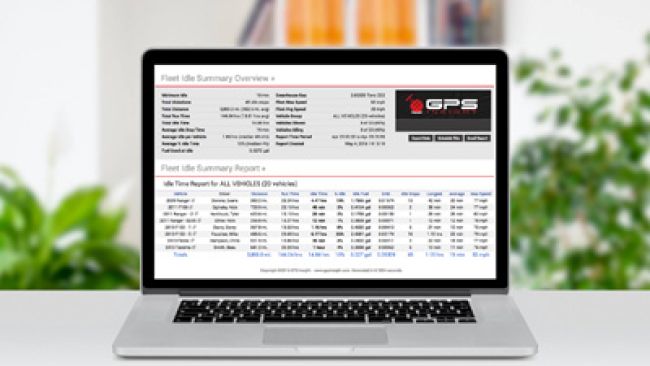
Getting Utility Fleet Drivers to Embrace Idle Reduction
Regardless of how cutting-edge a type of technology may seem, getting buy-in from prospective users often requires a pragmatic approach: They need to be convinced it works.
Such is the case with anti-idling technology. Today’s tools – aimed at reducing emissions and wasted fuel – include automatic shut-off systems, real-time alerts and plug-in hybrid vehicles that allow systems to work when the engine is off. But the only way utility fleet operators will fully embrace such tools, experts say, is when they grasp the difference that can be made, in terms of both the environment and their organization’s financial bottom line.
“It’s very spotty,” said Linda Gaines, transportation system analyst at Argonne National Laboratory (www.anl.gov) and a recognized idling authority. “You’ll go to some meetings and talk to some fleets, and they’re on board. It’s like your job is done, and the information is all out there. A lot of states have regulations, and it seems like we’ve made a lot of headway. And then you go and visit some company and see how far there still is to go.”
Gaines referenced one organization that is interested in idle reduction and went through the process of installing telematics, but, she said, was still “absolutely shocked by how much idling their trucks were actually doing. I think that’s not an unusual occurrence. Just by sharing that information with the drivers, without any kind of threat or any kind of reward, either way, just by being aware, the drivers reduced their idling by some very significant fraction.” That fraction was near 30 percent.
Raising Awareness
Neil Holladay, regional fleet manager with NPL (www.gonpl.com), an infrastructure construction company that specializes in utility construction services, said that in 2014, he and his sustainability committee co-chair were individually working on issues related to fuel and carbon footprint. When it came time for a presentation, they discovered they had both identified idling as the biggest threat – and opportunity. With a fleet of roughly 3,500 assets, the company was wasting more than $1.5 million in fuel annually due to idling. They discussed whether the best tactic would be to create an awareness campaign or write a policy; awareness won out.
“We put a campaign together that was pure saturation,” Holladay said. They shared data about the effects of idling at every turn, created no-idling areas and gave away $25 gift cards for success stories.
“It was like advertising: When you hear something for the 10th time, you’re sick of it,” he said. “But it’s OK for people to frown upon it or even poke fun. It will still catch someone’s eye. And when [it does], it’s going to be effective. You just can’t get discouraged. It takes a little time.”
Within a couple of months, NPL’s idling had dropped a few percentage points. A few months after that, “we were seeing a large 10 percent drop,” Holladay said. And within the first year, the company had saved more than 1 million pounds in carbon dioxide emissions and just over $188,000 in fuel costs.
Perhaps the best part is that many of the company’s fleet operators are outdoorsmen and parents, and they connected with the idea of environmental stewardship for future generations. But it did take changing thinking about the way things had always been done.
The Lowest-Hanging Fruit
When it comes to getting drivers to change their mindset about idle reduction, concrete numbers certainly help. So, too, does the proper equipment. Odyne Systems (www.odyne.com) is a leading manufacturer of hybrid systems for medium- and heavy-duty work trucks, and Matt Jarmuz, director of sales, sees such solutions as the lowest-hanging fruit in improving fuel efficiency and reducing emissions. In addition to powering, say, strobe lights and cabin comfort, Odyne’s large battery packs also can handle hydraulics and export power. And even while vehicles are in motion, the plug-in hybrid solution improves efficiency. As of press time, the company has placed roughly 300 vehicles in about 60 different fleets.
Jarmuz also is a strong proponent of telematics use and has seen fleets that, for example, have a system that sends an automatic email to a fleet manager when a truck idles for more than five minutes. Other fleets work from a more prevention-oriented coaching approach.
With hybrid technology, operators won’t feel that stopping idling is about “taking things away,” Jarmuz said.
But even without it, framing idle reduction as a gain – one that lowers fuel expenditures and contributes to reduced maintenance costs, greater asset reliability and longer vehicle service life – rather than a loss may well be the key to acceptance and implementation within your fleet.
About the Author: Fiona Soltes is a longtime freelance writer based just outside Nashville, Tenn. Her regular clients represent a variety of sectors, including fleet, engineering, technology, logistics, business services, disaster preparedness and material handling. Prior to her freelance career, Soltes spent seven years as a staff writer for The Tennessean, a daily newspaper serving Nashville and the surrounding area.
Photo: GPS Insight
*****
Idling by the Numbers
• Idling of heavy-duty and light-duty vehicles combined wastes an estimated 6 billion gallons of fuel each year.
• Many still believe that restarting a vehicle burns more fuel than letting it idle, but idling for 10 seconds wastes more fuel than a restart.
• Personal vehicles produce roughly 30 million tons of carbon dioxide every year due to idling. Eliminating the unnecessary idling of personal vehicles would be the equivalent of taking 5 million vehicles off the roads.
• Numerous states have enacted fines for unnecessary idling, including Massachusetts, Maryland, New Hampshire, New Jersey, Vermont and Hawaii, and parts of California, Colorado, New York, Ohio and Utah, among others. A list of state and local regulations is available at www.cleancities.energy.gov/idlebase.
Source: www.anl.gov/sites/anl.gov/files/Idling-PersonalVehicles050715.pdf

